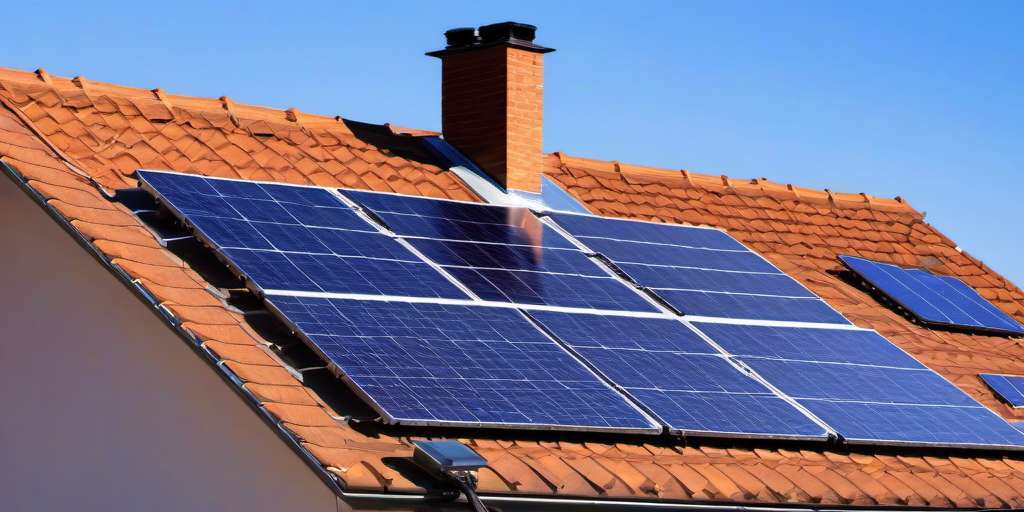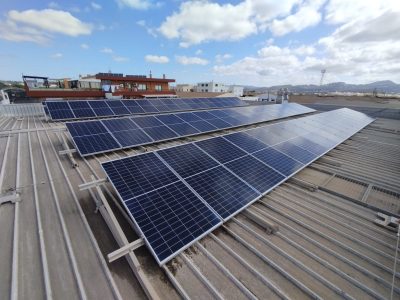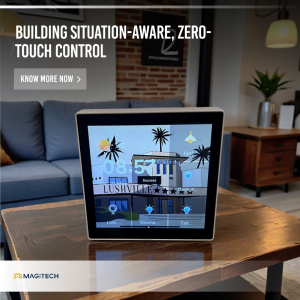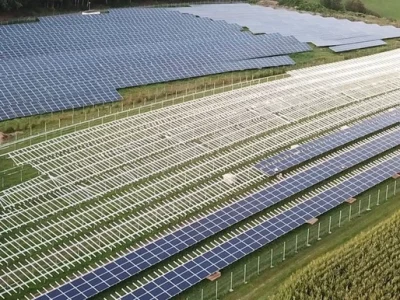Installing solar panels is gaining popularity due to their many benefits. It helps reduce electricity bills, protects the environment, and increases property value. It also provides energy independence. For proper installation, consider the roof’s orientation and slope, as well as its conditions and the type of tile materials used. Contact Ingeniera Masred for a personalized quote and professional advice.
Benefits of installing solar panels in your home
Installing solar panels in a home offers multiple advantages, both economically and environmentally. The main benefits are detailed below.
Savings on your electricity bill
One of the main reasons to install solar panels is the significant savings on your electricity bill. By generating your own energy, you reduce your dependence on the conventional electrical grid, resulting in lower monthly costs.
- Immediate reduction in monthly energy expenditure.
- Possibility of selling surplus energy to the grid.
- Protection against rising electricity prices.
Contribution to the environment
Solar panels are a clean, renewable source of energy that helps reduce your home’s carbon footprint. Using solar energy helps reduce dependence on fossil fuels and reduces greenhouse gas emissions.
- Reduction of CO2 emissions.
- Lower environmental impact compared to conventional energy sources.
- Contribution to sustainability and the fight against climate change.
Increase in property value
Installing solar panels can significantly increase the value of your home. Potential buyers find homes with solar panels an attractive option due to the energy savings and environmental friendliness.
- An additional attraction for potential buyers.
- Higher real estate valuations.
- Faster sale of the property.
Energy independence
Installing solar panels provides greater energy independence, enabling homeowners to generate their own electricity and reduce their reliance on utility companies. This offers greater autonomy and stability in the face of grid supply disruptions.
- Greater energy autonomy.
- Less vulnerability to power outages.
- Direct control and management of energy consumption.
Requirements for the installation of solar panels
For proper solar panel installation, it is essential to meet specific requirements that will ensure maximum system performance and efficiency.
Roof orientation and inclination
Roof orientation is a determining factor in the efficiency of solar panels. The ideal orientation is south, which allows for greater capture of solar radiation throughout the day.
The roof’s pitch is also crucial. A pitch between 25 and 35 degrees is recommended to maximize sunlight capture. This pitch can vary depending on the site’s geographic location and specific climatic conditions.
Roof conditions
The condition of the roof must be assessed before installing solar panels. The roof must be in good structural condition and have a useful life of at least 25 years, coinciding with the average lifespan of solar panels.
A roof in poor condition may require additional repairs before proceeding with the installation, which can increase the overall project cost.
Tile materials
Although most types of roof tiles are compatible with solar panel installation, it is essential to keep in mind some considerations:
- Ceramic tiles and slate tiles are suitable for installing solar panels.
- Metal tiles are also a good option due to their durability and ease of installation.
- It is essential to avoid shaded areas that can reduce the performance of solar panels.
If the roof is partially shaded, power optimizers or microinverters may be needed to minimize efficiency loss.
Types of solar panels
There are various types of solar panels available on the market, each with distinct characteristics that make them suitable for different uses and applications.
Monocrystalline solar panels
Monocrystalline solar panels are composed of monocrystalline silicon cells, which are manufactured from a single crystal of silicon. This enables them to achieve high efficiency in converting solar energy into electricity.
These panels typically have a uniform black color and are known for their durability and long lifespan. Thanks to their efficiency, they are ideal for installations in small spaces where energy production needs to be maximized.
Polycrystalline solar panels
Polycrystalline solar panels are made up of multiple silicon crystals, making them generally more affordable than monocrystalline panels. Although their efficiency is slightly lower, they are still an efficient and popular option.
These panels are typically mottled blue in color and are a good choice for those looking for an economical solution without sacrificing too much performance. They are suitable for installations where there is enough space to accommodate multiple panels.
Thin-film solar panels
Thin-film solar panels are made of thin layers of photovoltaic materials on a substrate, such as glass or metal. These panels are more flexible and lighter than monocrystalline and polycrystalline panels.
Although their efficiency is lower, their flexibility allows them to be installed on curved or irregular surfaces. They are ideal for applications where weight and flexibility are critical factors, such as unconventional roofs or building facades.
Comparison between different types of solar panels
When considering what type of solar panel to install, it is helpful to consider the specific characteristics of each type:
- Efficiency: Monocrystalline panels are generally the most efficient, followed by polycrystalline panels, and then by thin-film panels. This influences the amount of energy each panel can generate.
- Cost: Polycrystalline panels are generally less expensive than monocrystalline panels, while thin-film panels tend to vary in price depending on the specific technology used.
- Durability: All solar panels have a long lifespan; however, thin-film solar panels may degrade more quickly under certain environmental conditions.
- Applications: Monocrystalline and polycrystalline are ideal for standard residential and commercial roofs, while thin-film solar panels are preferred for more specialized or architecturally demanding applications.
Components of a solar panel installation
A solar panel installation comprises several key elements that enable the capture, conversion, storage, and management of solar energy.
Solar panels
Solar panels are the main component of the installation. They capture the sun’s energy and convert it into electricity. The most common types are:
Monocrystalline solar panels
Manufactured from high-purity silicon, these boards are known for their high efficiency and durability. Their performance is optimal in confined spaces and under low-light conditions.
Polycrystalline solar panels
Made from fused and crystallized silicon, these panels offer lower efficiency compared to monocrystalline panels, but are more economical and work well in sunny climates.
Thin-film solar panels
These panels are made of materials such as cadmium and tellurium, and are flexible and lightweight. Although their efficiency is lower, they are ideal for specific applications such as curved roofs or moving surfaces.
Comparison between different types of solar panels
Monocrystalline panels offer the highest efficiency and are ideal for small spaces. Polycrystalline panels are a cheaper but less efficient option. Thin-film panels, although less efficient, are versatile and lightweight.
Investors
Inverters are essential for converting the direct current (DC) generated by solar panels into alternating current (AC), which is compatible with household electrical appliances. There are several types of inverters:
Central investors
This type of inverter manages the power of the entire solar panel system, making it ideal for large installations.
Microinverters
Each solar panel has its own microinverter, which optimizes individual performance and facilitates the detection of faults.
Power optimizers
They are installed on each solar panel to optimize its performance before sending the power to a central inverter. They combine the advantages of central inverters and microinverters.
Batteries
Batteries store the energy generated by solar panels for later use. They are crucial for ensuring power supply at night or on cloudy days. The main types are:
Lead-acid batteries
Traditional and economical, they have a shorter lifespan and lower efficiency compared to other options.
Lithium-ion batteries
They offer higher energy density, longer lifespan, and efficiency, although they are more expensive.
Flow batteries
Ideal for large-scale storage, they allow for greater storage capacity with a long shelf life.
Support structures
Support structures are crucial for maintaining the position and orientation of solar panels. They are designed to withstand a variety of weather conditions. The most common types include:
Roof supports
Installations directly on the roof, adjusted to its slope and orientation.
Floor supports
Useful when rooftop installation isn’t possible. They offer flexibility in orientation and inclination.
Solar tracking systems
They allow the panels to move along the sun’s path, increasing the efficiency of energy capture.
Monitoring systems
These systems enable you to monitor and manage the performance of your solar installation in real-time. They provide detailed information on energy production and the status of components.
Local monitoring
Provides real-time data directly from the inverter, accessible locally.
Cloud Monitoring
It enables remote access to performance data through applications and web platforms, facilitating monitoring and preventive maintenance.
Solar panel installation process
The solar panel installation process involves several essential steps to ensure an efficient system that meets your energy needs.
Energy consumption assessment
The first step is to conduct a detailed assessment of the home’s energy consumption. This analysis determines the amount of energy required and, consequently, the number of solar panels necessary.
Feasibility study
The feasibility study assesses whether installing solar panels is feasible given the home’s location. Factors such as the roof’s orientation and slope, its condition, and the geographic area are crucial.
System design
Using the information obtained in the previous steps, the system design begins. This includes details on the panel layout, the type of inverters and batteries, as well as any other necessary components.
The key components of the system are usually:
- Solar panels
- Investors
- Batteries
- Support structures
- Monitoring systems
Installation and connection to the electrical grid
The physical installation process of solar panels involves mounting them on the roof, connecting them, and then integrating them with the home’s electrical system. Connecting to the electrical grid is a fundamental step that professionals must perform to ensure proper operation.
Maintenance and monitoring
Maintenance is key to ensuring the durability and efficiency of your solar system. It includes regular panel cleaning and periodic technical inspections. Constant monitoring enables the early detection and resolution of any issues that may arise.
Factors that influence the installation price
The cost of installing solar panels can vary depending on several factors. Understanding these factors is essential for planning and optimizing your investment.
Size and number of panels
The number of solar panels needed depends on energy consumption and available roof space. The more panels you have, the higher the initial cost, although it also increases energy generation capacity, offering long-term savings.
Geographic location
The geographic location of a home significantly affects the amount of solar radiation it receives. Regions with more hours of sunshine per year allow for greater efficiency of solar panels, thus influencing the return on investment.
Roof features
Roof condition is crucial. Factors such as orientation, pitch, and roof condition can influence the installation cost. A roof in poor condition may require prior repairs, which can increase the overall project budget.
Types of inverters and batteries
Inverters convert solar energy into usable electricity. There are different types of inverters, including string inverters and microinverters, each with distinct features and pricing.
Batteries
Batteries are used to store excess energy generated by solar panels. Battery types, such as lithium-ion and lead-acid, vary in terms of capacity, durability, and price. Choosing the correct battery can significantly influence the cost and efficiency of the system.
Available grants and aid
There are various grant and assistance options available to reduce the cost of installing solar panels. These grants can be obtained from local, regional, or national programs and may include tax deductions, direct financial assistance, and favorable financing terms.
- Grants for installation
- Tax deductions
- Financing programs
Consult with available assistance during installation to maximize investment opportunities.
Subsidies and aid for the installation of solar panels
In Spain, various subsidies and grants are available to encourage the installation of solar panels, offering financial support and tax benefits to those who opt for renewable energy sources.
Types of grants available
The grants available for solar panel installation can be classified into various categories, depending on the source and purpose of the financial support.
- Regional subsidies: These grants are managed by the autonomous communities and vary by region. They usually cover a percentage of the total installation cost.
- State subsidies: The central government also offers national aid programs, such as the Recovery, Transformation, and Resilience Plan, which funds renewable energy projects.
- European subsidies: The European Union provides funding for the energy transition through programs such as the European Regional Development Fund (ERDF) and Horizon Europe.
Requirements for obtaining aid
To qualify for grants and subsidies for installing solar panels, you must meet a series of specific requirements that may vary depending on the source of funding.
- Residency in the area: For regional subsidies, it is necessary to reside in the autonomous community that provides the aid.
- Viable project: The project must meet specific technical and economic criteria to ensure its viability and energy efficiency.
- Documentation: It is essential to present a series of documents, including municipal permits, energy efficiency certificates, and pro forma invoices.
Application procedure
The procedure for applying for grants and subsidies for installing solar panels involves several steps that must be followed carefully.
Submission of the application
The first step is to apply to the appropriate agency. This can be done online or in person, depending on the guidelines of each aid program.
Project evaluation
Once the application is submitted, the project will be evaluated by specialized technicians who will verify compliance with the established criteria.
Approval and granting
If the project meets all requirements, the grant will be approved and awarded. The applicant will receive notification and a timeline for the installation to begin.
Tax benefits
In addition to direct subsidies, the installation of solar panels can also benefit from various tax advantages that facilitate the return on investment.
- Personal Income Tax Deductions: In some autonomous communities, it is possible to obtain tax deductions on the Personal Income Tax (IRPF) for the cost of the installation.
- Property Tax Rebates: Many city councils offer property tax rebates for homeowners who install solar energy systems on their homes.
- VAT Reduction: In certain circumstances, the VAT applied to solar panel installation can be reduced, representing a significant savings in the total cost.
Comparison of solar installations
Solar installations can be tailored to various property types, including single-family homes, residential communities, businesses, and commercial establishments. Below, we discuss the specific features and advantages of each option.
Single-family homes
Installing solar panels on a single-family home is an excellent option for reducing electricity bills and increasing the home’s energy independence. These installations are typically more straightforward and more customizable.
Advantages include:
- Significant savings in electricity consumption
- Increase in property value
- Less dependence on electricity companies
- Option to integrate energy storage systems
To get the most out of it, the roof must be in good condition and properly oriented.
Neighborhood communities
Installing solar panels in residential communities enables the optimal use of available space and benefits shared among all residents. This type of installation requires greater coordination and agreement among neighbors, but offers significant advantages.
Advantages of installations in neighborhood communities
- Reducing installation costs by sharing expenses
- General reduction in community electricity bills
- Improving the overall value of the building
- Possibility of integrating with collective self-consumption systems
It is essential to conduct a feasibility study and obtain the necessary permits for this installation to proceed.
Companies and businesses
Solar installations in companies and businesses not only help reduce operating costs but also improve corporate image by demonstrating a commitment to the environment.
Benefits for companies and businesses
- Long-term energy cost reduction
- Possibility of accessing subsidies and tax benefits
- Improved competitiveness by reducing operating costs
- Added value through corporate social responsibility
This type of installation can be complex due to the project’s scale and the need to integrate it with business operations.
Particular considerations
- More space available on roofs or adjacent land
- Possibility of integration with advanced monitoring systems
- Option to use power purchase agreements (PPAs) to finance the installation
Companies must conduct a detailed analysis to maximize their return on investment.
Incorporation of aerothermal energy with solar installations
Integrating aerothermal energy with solar installations enhances energy efficiency, offering a comprehensive and sustainable solution for home energy consumption. Below, we explain how to combine both systems and their benefits.
What is aerothermal energy?
Aerothermal energy is a technology that harnesses the energy contained in the air to produce heating, cooling, and domestic hot water. It uses a heat pump to extract thermal energy from the outside air, even in low-temperature conditions. This system is highly efficient, as it generates more energy than it consumes, significantly reducing the need for fossil fuels.
Advantages of combining aerothermal energy and solar energy
The combination of aerothermal and solar energy has several key advantages:
- Greater energy efficiency: By combining both technologies, the use of renewable resources is optimized, and clean energy production is maximized.
- Cost reduction: Integrating aerothermal energy with solar panels can significantly reduce electricity and heating bills.
- Self-consumption: The energy generated by the solar panels can be used directly to power the aerothermal heat pump, increasing energy self-sufficiency.
- Lower environmental impact: This combined system utilizes renewable energy sources, thereby reducing emissions of CO₂ and other pollutants.
- Increased property value: Energy-efficient installations add value to any property, enhancing its attractiveness in the real estate market.
Joint installation of aerothermal energy and solar panels
Joint installation requires a detailed study to ensure the efficiency and compatibility of both systems. The steps to follow are:
- Initial assessment: Analysis of energy consumption and property conditions to determine the number and type of solar panels, as well as the capacity of the air source heat pump.
- System design: Development of a project that includes the integration of solar panels and the heat pump, optimizing their joint operation.
- Installation: Placement of the solar panels on the roof and the heat pump in a suitable location, ensuring that both systems can operate efficiently and in coordination.
- Connection: Integration of both systems into a single electrical and thermal circuit to maximize the generation and use of renewable energy.
Energy savings with aerothermal energy and solar panels
The energy savings are significant when combining these two technologies. Some aspects to consider are:
- Reduction in electricity consumption: Solar panels provide the energy needed to operate the heat pump, reducing dependence on the electrical grid.
- Optimizing the use of generated energy: Solar energy powers the aerothermal system, storing surplus energy in batteries for use during non-sunlit hours.
- Flexible use: In addition to heating and cooling, the combined system can provide domestic hot water, maximizing the energy generated.
- Subsidies and tax benefits: The joint installation of aerothermal energy and solar panels can benefit from subsidies and tax deductions, which facilitate the initial investment and improve long-term profitability.
Success stories and testimonials
The installation of solar panels has yielded multiple success stories and testimonials that reflect both the positive economic and environmental impacts. Below are some of these experiences.
Testimonials from satisfied customers
Customers from various geographical areas have shared their positive experiences after installing solar panels.
- María Gómez, Madrid: “Thanks to installing solar panels, my electricity bill has dropped significantly. Plus, I feel like I’m doing my part to protect the environment.”
- José Rodríguez, Seville: “The installation was quick and efficient. The monitoring system is easy to use, and we are now energy self-sufficient for much of the year.”
- Laura Sánchez, Bilbao: “We opted for a combined installation with aerothermal energy, and we’re delighted. The energy savings are considerable and the experience has been very positive.”
- Carlos Fernández, Valencia: “Masred Engineer offered us personalized advice, and the installation exceeded our expectations. The value of our property has also increased thanks to this investment.”
Projects carried out by Masred Engineering
Masred Engineering has carried out numerous successful solar panel installation projects in various locations, each tailored to the specific needs of its clients.
- Single-family home in Barcelona: A system of 10 monocrystalline panels with inverters and battery storage, providing clean and sustainable energy year-round.
- Residential community in Zaragoza: Installation of a shared solar system that covers 60% of the energy needs of all residents, with an ongoing monitoring and maintenance plan.
- Company in Malaga: Customized solution for a factory that needed to reduce its dependence on the power grid. Fifty polycrystalline panels and an advanced inverter system were installed, achieving significant energy independence.
Economic and environmental impact
Solar panel installations have not only generated significant savings on electricity bills but have also made substantial contributions to environmental protection.
- Cost reduction: Families and businesses have reported a reduction of up to 70% in their monthly energy bills thanks to solar panels and aerothermal energy.
- Smaller carbon footprint: Solar energy significantly reduces CO2 emissions. Many Masred Engineering projects have successfully managed to avoid emitting tons of polluting gases per year.
- Reinvestment of savings: The savings generated have enabled homeowners to reinvest in additional energy and technological improvements, fostering a continuous cycle of efficiency and sustainability.
Contact Masred Engineer
Masred Engineering offers customized solutions and specialized technical support for installing solar panels in your home.
Request a technical visit
To ensure an optimal installation tailored to your needs, the first step is to schedule a technical visit. During this visit, our professionals will assess the specific characteristics of your home, including the orientation and slope of the roof, the condition of the roof, and the type of tile materials.
Once the technical visit is completed, a detailed report will be provided, including personalized recommendations and a preliminary installation plan.
Get a personalized quote
Using the information gathered during the technical visit, Ingeniera Masred will prepare a quote tailored to your needs and budget. This report will include:
- Calculation of the quantity and type of solar panels needed.
- Cost of individual components, such as inverters, batteries, and support structures.
- Estimate of labor and installation times.
- Possible grants and aid available.
Advice and technical support
Ingeniera Masred will not only be responsible for the installation of the solar panels, but will also offer comprehensive consulting and technical support. This includes:
Pre-installation advice
Our experts will guide you through the process, providing information on the advantages of different types of solar panels, as well as the best options for inverters and batteries.
Support during installation
The Masred Engineering technical team will be present throughout the installation, ensuring that all components are integrated efficiently and effectively.
Post-installation support
Once the installation is complete, you’ll have access to regular maintenance and monitoring services. The monitoring systems installed will allow you to monitor the performance of your solar panels and receive technical assistance H4: when necessary.
Preventive maintenance
Masred Engineering offers preventive maintenance services to ensure your solar installation operates optimally throughout its entire lifespan. This service includes panel cleaning, connection inspection, and software updates for monitoring systems.







